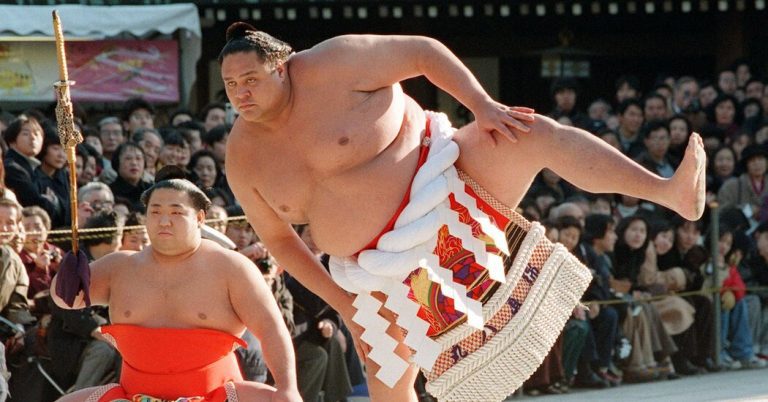Taro Akebono, a Hawaiian-born sumo wrestler who became the sport’s first foreign grand champion and helped revive the sport’s popularity in the 1990s, has died in Tokyo. He was 54.
He died of heart failure in early April while being treated at a Tokyo hospital, according to a family statement released by the United States military in Japan on Thursday.
When he became Japan’s 64th yokozuna, or grand champion sumo wrestler, in 1993, he was the first foreign-born wrestler to achieve the sport’s highest title in its 300-year modern history. He won a total of 11 major championships, and his success set the stage for an era in which foreign-born wrestlers dominated the top levels of Japan’s national sport.
Akebono, who was 6-foot-8 and 466 pounds when he was first named yokozuna at age 23, towered over his Japanese opponents. Painfully shy outside the dohyo, as the sumo ring is known, he was known for using his height and reach to keep opponents at bay.
Akebono’s rivalry with the Japanese brothers Takanohana and Wakanohana, both grand champions, was a key driver of sumo’s renewed popularity in the 1990s. During the opening ceremony for the 1998 Winter Olympics in Nagano, Japan, Akebono introduced the ritual of entering the sumo ring for an international audience, rules the arena with his bulky physique and seductive look.
Taro Akebono was born Chad George Ha’aheo Rowan in Waimanalo, Hawaii in 1969. He played basketball in high school and briefly at Hawaii Pacific University before moving to Japan in 1988 at the invitation of a fellow Hawaiian wrestler-turned-coach.
Knowing nothing about Japan and speaking almost no Japanese, the teenager began living and training in a sumo stable ruled by a strict hierarchy, cooking and cleaning for more experienced wrestlers. He soon records a meteoric rise through the ranks of the sport, dominating with his size.
“We were just brute force,” he said in a later interview, referring to himself and other wrestlers from Hawaii in the 1990s. “We won fast or lost fast. We weren’t very technical.”
In 1992, the Yokozuna Promotional Council, which decides which wrestlers deserve sumo’s top honor, denied it to another Hawaiian, saying no outsider could have the dignity the title deserved. The decision prompted allegations of racism and raised questions about the council’s selection process. Only a few wrestlers hold the title at the same time, and it is chosen through a vote from candidates who have won two consecutive tournaments.
A year later, just five years after arriving in Japan and taking up the sport, Akebono broke that barrier.
He later said in interviews that he rarely considered his ethnicity in the ring, considering himself a sumo wrestler first and foremost. He became a naturalized Japanese citizen in 1996 and changed his name to Taro Akebono. His chosen sumo name, ‘Akebono’, means dawn in Japanese.
“I wasn’t thinking, ‘I’m an American, I’m going to go out there, plant my flag in the middle of the ring and face the Japanese,'” he told The New York Times in 2013.
He gained acceptance and popularity in the sumo world in part because people in Japan appreciated his dedication to the sport, even though in his early matches, the cheers from the crowd were much louder for his Japanese-born opponents.
“He makes me forget he’s a foreigner because of his serious attitude toward sumo,” said Yoshihisa Shimoie, editor of Sumo magazine, in 1993. By the early 2000s, dozens of ranked wrestlers were foreigners, including Mongolian, Georgian and Argentinian.
According to family, Akebono is survived by his wife, Christine Rowan, daughter Caitlyn, 25, and sons Cody, 23, and Connor, 20.
In 2001 he retired from the sport at the age of 31, citing chronic knee problems. He continued to train younger wrestlers and also competed in kickboxing, professional wrestling and mixed martial arts.
“I retire with a feeling of great gratitude that I was given the opportunity to become a yokozuna and experience something open to very few people,” he said at the time of his retirement.
Motoko Rich contributed to the report.




